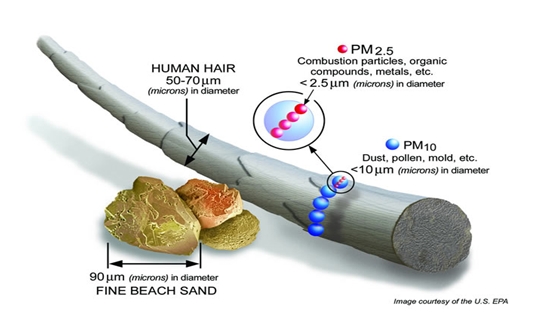What is PM10 and PM2.5?
Besides gaseous pollutants, the atmosphere can also be polluted by particles. These particles (either in suspension, fluid or in solid state), have a divergent composition and size and are sometimes called aerosols. They are often catalogued as 'floating dust', but are best known as particulate matter (PM).
This floating dust is most often categorised based on their aerodynamic diameter. The aerodynamic diameter of a dust particle is the diameter of a sphere-shaped particle that shows the same behaviour in the atmosphere as a dust particle (which does not necessarily have a sphere shape). In the framework of air quality problems, particulate matter is the most important.
Particulate matter such as PM10, PM2.5, PM1 and PM0.1 is defined as the fraction of particles with an aerodynamic diameter smaller than respectively 10, 2.5, 1 and 0.1 µm (for your information: 1 µm = 1 millionth of a meter or 1 thousandth of a millimeter). In comparison, the average diameter of a human hair equals 50-70 µm (see figure below)

Bigger particles, after being emitted into the atmosphere, quickly get taken down by gravity or are washed out by rain. The finer particles can remain in the atmosphere for a longer time (a couple of days to weeks). As such, these finer particles can be transported over longer distances. Another consequence of this longer stay in the atmosphere is the possible alteration of composition and the change of characteristics of the particles because of physicochemical processes.

Source: C. Trimbacher Umweltbundesamt Wien
This picture is a electron microscopic image of particulate matter on a filter that was placed near a road. Black carbon (the little, grey balls) is ubiquitous on this filter. The light blue balls are particles originating from combustion processes; while the pink particles are minerals and the green cubes are salts.
